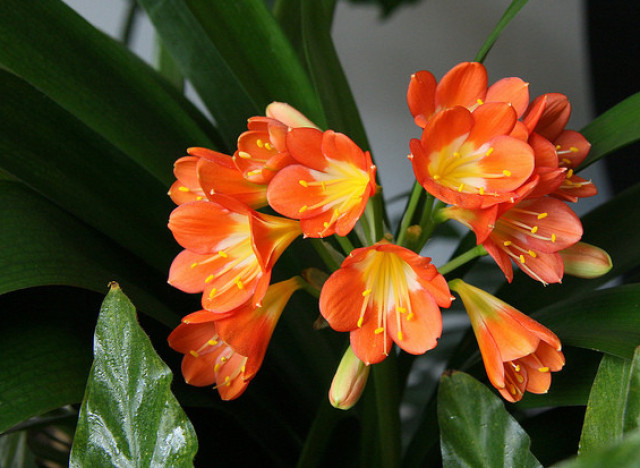This South African native the Kaffir lily, or the Clivia, is strong and pretty at the same time but not actually a lily. The herbaceous evergreen plant has large tongue-like leaves that are thick and sturdy. Most Kaffir lilies are forest plants that run around the forest floor under trees and thriving in low light conditions blooming in late winter and spring. The Clivia miniata can bloom at other times however, making it the most cultivated variety used as a houseplant.
When kept as a houseplant the Clivia miniata 'Kaffir lily' likes to be kept from evenly moist to slightly dry during the warm months but not wet. As the temperature gets cooler in the fall through winter, pull back on the watering and let it rest. They enjoy the sleep in the cooler air (55-65 degrees) and actually need it. Without this cooling time the flowering structure will not be activated thus it will rarely re-bloom. The cooler it is the more you need to let it dry out thoroughly or you will run the risk of rotting the plant. Just as in the forest, the Kaffir lily prefer a bright filtered light making sure not to give it direct sun. If you keep one as a houseplant you can bring it outside for the warm season as long as you keep it in the shade and bring it in before it gets it gets too close to frost level. If you have a heavy rain season where you live it is advisable to keep your Kaffir lily in a semi covered area as to not let it get too consistently wet.

Flickr photo by blumenbiene
The Kaffir lily enjoys to be tight in the pot and does not require to be re-potted all of the time. When you have to, use a well draining, all-purpose potting mix or a coarse orchid mix preferably in the spring and just after bloom when the plant is being very active. Only give it a scant more room in regards to the size of the new pot. It is all right that it looks like the plant is pushing out of its old home, it is not normally a sign of stress. Fertilize the Kaffir lily during the warm season with a diluted organic fertilizer and stop fertilizing it come fall in preparation of sleep time. When potting and feeding, keep in mind that they prefer a slightly acidic soil and its soil and what you are feeding it with will have a role in the level.
It can take a long time for the Kaffir lily to flower, sometimes five years when started as a seedling, so if you have the opportunity to pick up a more mature specimen that is advisable unless you have the patience. Once the plant is done with its bloom cut the stalk at its base just as you would with an Amaryllis so that the plant will not go in to seed and let it conserve its energy. As the flower stalk grows and blooms turn the container once and a while so the plant will not lean and to show off the best that this 'pretty strong' plant has to offer.
Have something to say? Check out HuffPost Home on Twitter, Facebook, Pinterest, Tumblr and Instagram.
**
Do you have a home story idea or tip? Email us at homesubmissions@huffingtonpost.com. (PR pitches sent to this address will be ignored.)